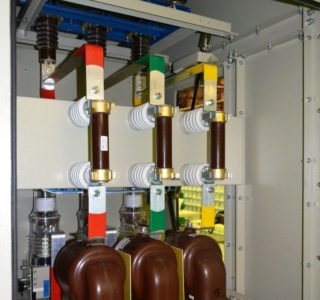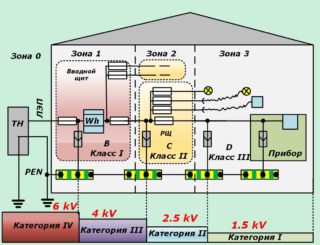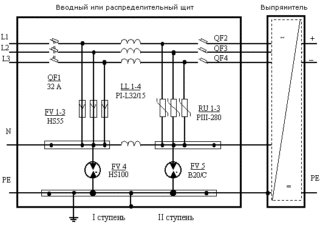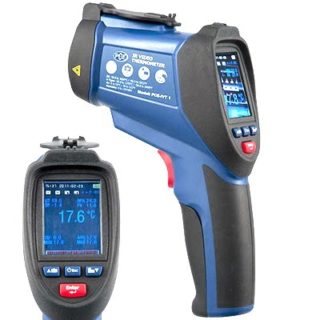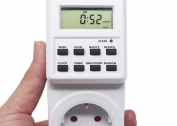Non-linear surge arrester or surge suppressor is the main apparatus (switching device) for protecting the power line branch from sudden surge surges. He replaced the valve resistors. The production and installation standards are introduced by GOST R 52725-2007. In different sources, to designate a limiter, the concept of a spark gap without spark gaps or the abbreviation UZPN is used.
The need for surge protection
Impulse overvoltage - a sharp increase in the potential difference in the network, exceeding the maximum limit of the operating voltage. Short jump - up to 1 nanosecond (1 • 10-9 sec.), therefore, conventional USMs may not have time to work and let the pulse pass into the internal power supply network. The amplitude can exceed the nominal 10 times.
Origin:
- atmospheric (thunderstorm) - caused by lightning with an average current strength of 200 kA in the lightning conductor of the house or in objects near it (the current goes into the ground, but EMF appears in the house wiring);
- switching - malfunctions or replacement of switching equipment / sections of the circuit, the launch of powerful electrical equipment, failure of the transformer.
Regardless of the nature of the occurrence, such malfunctions carry a risk for all connected devices: ignition of the wiring insulation (rated for 1-1.5 kV), damage to the electrical circuits of the devices and their complete unsuitability for repair.
The device and principle of operation of a nonlinear limiter
The operation of the arrester is based on the specific property of a varistor - a semiconductor with a non-linear current-voltage characteristic. With a regular potential difference, the permeability of the element tends to zero and amounts to several mlA. A sharp surge in voltage opens tunneling conductivity (> 1000 Am), the resistance practically disappears, the pulse is promptly removed from the system. The material of the conductor is zinc oxide, sometimes with the addition of oxides of other metals (cobalt, bismuth, etc.).
The arrester consists of circular resistor plates (the number is oriented to the rated overvoltage), which are folded into a column, placed in a fiberglass tube and sewn into a ribbed insulating jacket. Tightness ensures filling the voids with a viscous silicon-organic composition. On both sides, the structure is tightly clamped by flanges. A feature of the device in the implementation of fast and safe removal of thermal energy into the environment is that during the reception of a pulse, the varistor temperature reaches 100-150 ° C.
The design of modern modular limiters is different. This is a plastic case 17.5 mm wide (SPE-1), which contains a thermal fuse, a removable varistor unit and notched terminals. There are models with indicator lights. They have a din rail mount.
A power cable is fixed on one side of the limiter, and grounding on the other.
Types and main characteristics of arrester
Surge voltage limiters are distinguished by insulating material (porcelain and polymer), structural design (single-column and two-column), voltage and protection classes. From the decryption, it is clear what an arrester is in an electrician. Reading designations according to GOST:
OPN - X - 1/2/3/4 XX
The first abbreviation stands for non-linear surge suppressor. On the market, options for products of OPS (S - network) or SPE (I - pulse) are possible.
- X - tire material: P - polymer, without a letter - porcelain;
- 1 - class of network voltage in kV: 1.5, 4, 6, 10, 36;
- 2 - the largest operating voltage, kV: 3 - 475;
- 3 - rated discharge current, kA: 5, 10, 20;
- 4 - throughput current, A (up to 200 - 1 throughput class, 750 - 2, 1100 - 3, 1600 - 4, over 1601 - 5);
- XX - letters indicate the climatic region or their combination (common: U - moderate, Chl - cold, UHL), the number indicates the conditions of placement (1 - in the open air, 2 - under a canopy, 3 - indoors, 4 - in spaces with artificial climate control, 5 - in conditions of high humidity).
The description of modular arrester indicates the number of poles P1-4.
Classes of protection and network connection of arresters
For comprehensive protection of internal power supply systems against the penetration of a powerful destructive impulse, the arresters are distributed in stages depending on the protection class.
- Class B accepts the effects of a direct lightning strike on a power line or home electrical protection equipment. It is installed on the external switchboard to enter the power line to the structure.
- Class C copes with switching surges and lightning surges that have passed the first stage of protection. The device is placed in the main distribution panel inside the cottage or in the extension-garage, the entrance of a multi-storey building, on the administrative building floor.
- Class D is designed to extinguish residual effects. Useful just before electrical appliances. The limiter can be integrated into the outlet.
The connection circuit of the arrester has its own characteristics for a single-phase and three-phase network, TNC and TNS grounding principles (combined or not, main and protective conductor).
Devices are installed parallel to the main network in front of the auxiliary generator, meter and other equipment. To avoid the consequences of a possible short circuit to ground, use a circuit breaker in front of the arrester.
In the circuit of connecting the OIP-1 to a single-phase network, a power line is suitable for one terminal, and a ground cable is fixed to the other. When separating zeros, the main one is connected to the earth separately. A three-phase network involves the protection of each phase separately (and zero for TNS).
Safety and effectiveness of electrical protection equipment
The safety of electrical systems in administrative buildings and apartment buildings is the responsibility of utilities. In a private house, the owner himself takes care of security.
Installation of arresters should be entrusted to a professional, although the complexity is initially invisible. It is important to avoid cheap low-quality equipment, which itself can become a hotbed of danger. The use of electrical equipment must be strictly in accordance with the technical specifications.
Check the serviceability of the equipment rationally in the month of March – April before the start of the thunderstorm season. There are 2 main methods for diagnosing protective devices: non-contact measurement of the heating temperature with a thermal imager is carried out first of all, according to the results, the transmitted current is additionally controlled by a micro- or milliammeter.
The modular voltage limiter is equipped with a health indicator window: green indicates a willingness to perform functions, red indicates a malfunction. In the latter case, the operational replacement of the varistor part is prescribed. Thus, this type of electrical equipment is easier to use at home.
Arrester - electrical equipment that protects against short-term power surges of large amplitude. It is not able to cope with a stable overvoltage or a drop in the potential difference, therefore it is used in combination with USM and RCD.
